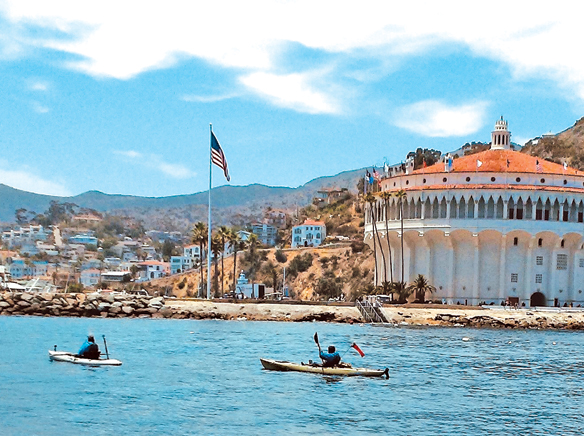
Cast and crew associated with an independent movie under development entitled “Two Nations” landed on Catalina Island this week in an effort to highlight the role of native Americans in the island’s history and in part to promote the movie.
Robert Redfeather, an assistant executive producer on the project, and a member of the Mescalero Apache Tribe from New Mexico, paddled across the Pacific from Newport Beach to Catalina.
Accompanying by a chase kayak and a full crew in a larger boat, it took Redfeather more than 13 hours to paddle from Newport Beach to Catalina Island. “I did have some breaks to rest and to eat energy bars,” he said. His exploits were documented by a film crew and photographers traveling in the larger boat.
In addition to his production role, Redfeather says he is also playing the role of Chief Strong Bear in the upcoming movie to be directed by Mark Ridley.
With a projected budget of between $4-5 million, the independent movie traces the blending of two critical ‘nations’ in the founding of the American continent; the African American nation and the nation of native Americans.
“This is a full grassroots production; cast, crew, sponsorship, and administration, consists of a collective of people all across the country of diverse race, ancestry, and culture who want the unspoken truth, yet a significant and intrinsic part of our AMERICAN history, told. Two Nations is the true ancestral love story of author and screenwriter Ruby Lee Thigpen-Whitehurst, told in the Spirit of many nations,” said Redfeather.
“As a grassroots production, we’re doing this on our own, because this is our story, and want to have the final creative rights to tell our story of the slave trade and the Native tribes of America that helped free many enslaved Africans of rich nations,” he added.
According to Redfeather, “it is a topic that has been overlooked, and usually not told by an African and indigenous perspective. We’re showcasing undiscovered talent that has been overlooked by mainstream entertainment.”
He said about 15 representatives from the cast, crew and investors gathered on the island to have lunch. Catalina is being considered for scenes in the movie, he said, but most of it will be shot in North Carolina.
“Everyone was excited about coming to Catalina Island, said Redfeather, “and I absolutely loved it.”
According to historical accounts on the Catalina Island Chamber’s website, “people have been living on Santa Catalina Island for at least 8,000 years. Archaeologists excavating on a limited scale at Little Harbor on the seaward side of the Island have found evidence of increasingly complex material cultures. These earlier groups of peoples exploited the rich resources of the sea–from abalone and other mollusks, to small and large fish, and marine mammals such as sea lions.
Over the millennia, as peoples migrated through California, different groups of Native Americans would have made their homes on the Island. For several thousand years before European contact, the Los Angeles basin and the Southern Channel Islands (Santa Catalina, San Clemente, and San Nicholas) appear to have been inhabited by peoples of linguistic affinity–the Takic branch of the Uto-Aztecan language family.
At the time of first European contact, it is thought that the people living on Santa Catalina Island called their island Pimu and themselves Pimungans (or Pimuvit). They were excellent seamen and paddled their plank canoes skillfully across the sometimes treacherous channel to trade.
After Spanish colonization, their apparently flourishing population declined drastically with the introduction of new diseases to which they had little immunity. As the mission system altered the economic landscape of Southern California, the Pimungans’ trade and social networks were disrupted,” the historical account concludes.
In the aftermath of this enormous culture shock, their society could no longer sustain itself. By the mid-1820s, the few Pimungans left had migrated or were moved to the mainland. The Pimungans, along with other Native American groups that were in the sphere of influence of Mission San Gabriel, came to be referred to in the European community as Gabrielinos. There are people living in the Southern California area today who have Gabrielinos among their ancestors.
Redfeather said there will be exact release date for the movie until it is complete but he expects it to be out within two years.










